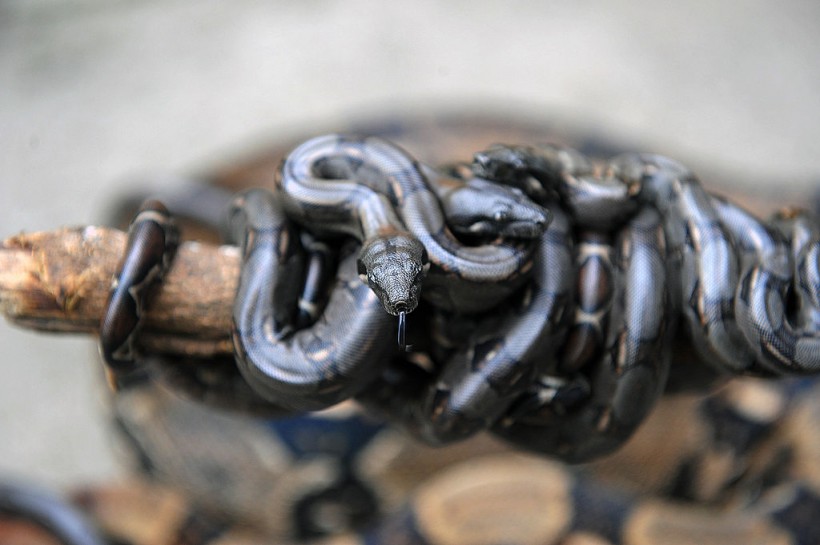A bunch of cobras tangled up in each other in a fight to win a tree branch in the forest was captured in a video. A clip of the snakes was shared on Instagram and it has gone viral with thousands of views and likes. Many were surprised at the sight of the reptiles forming like a giant ball while hanging on a tree.
Although many found the footage bizarre or shocking, it is a common ability among the reptiles called "snake knotting." Healthy snakes can knot and unknot themselves except if they have a certain health condition that does not allow them to do so. See below how the cobras try to knot themselves with each other to win that single branch.

Some of thirty-one boa constrictor offsprings coils up in a branch, three days after birth on June 4, 2008 at the National Biodiversity Institute (INBIO) park in Santo Domingo de Heredia, some 30 km north of San Jose.
King Cobras vs. Indian Cobras
The video posted by Instagram user 'snake._.world' shows King cobras and Indian cobras climbing over each other as if fighting to stay on the thin branch, Ary News reported. One of them could even be seen falling while fighting.
It has gone viral on social media with over 18,000 views and 1,800 likes. A few commenters on the post suggested that the snakes could be mating which is why they look like they are tangled up on the tree branch.
However, as seen from the video, the Indian cobra is trying its best to get freed from the grip of the King cobra. It is twisting and making a lot of effort to get rid of the other snake but fails in vain. Towards the end of the video, it can be seen that the King cobra swallows the tail portion of its prey, suggesting that it has won the fight.
Cobras are known to engage in snake-eating behavior in a phenomenon called ophiophagy. A 2018 study reported that many cobra species eat their own kind and has made serpents the majority of their diet. But for the most part, they prey on other species than their own.
Researchers also noted that most of the ophiophagy cases are between male snakes. Admittedly, the dataset is small and it is possible that females commit cannibalism too. Given the data, researchers hypothesized that the behavior could be attributed to survival or securing a mate, as eating a competitor will guarantee either result.
ALSO READ: Cannibal Reptiles: Snake Eating Another Snake Caught in A Video; Why Do They Eat Their Same Kind?
Snake Knotting: Why Do These Legless Reptiles Tie Themselves in A Knot?
Snakes can knot or wriggle themselves with a dexterity that would leave a Boy Scout or sailor in awe. According to the Washington City Paper website, the knot-tying abilities of snakes are due to the remarkable combination of flexibility and muscle control that makes it possible for them to move the way they do.
Snakes can tie themselves in a knot by gathering themselves into a series of close-spaced bends, like a concertina or accordion instrument, then pushes their body forwarded as it straightens out.
Constrictors, pythons, and other snake species have more vertebrae per unit of body length, allowing them to tie themselves into knots and balls, like the well-known ball python. They hide their heads in the middle of the tangle as a defense mechanism and remain motionless until the predator leaves.
Meanwhile, other snakes tie themselves into a knot to help shed old skin. This is mainly seen among sea snakes compared to land snakes because they often lack a convenient source of friction to help pull their skin off.
But snake knotting is not always a good sign. For snakes unable to unknot themselves, it could mean that they are infected with inclusion body disease (IBD) coming from a distant relative of Ebola. It is a fatal disorder that causes various neurological symptoms in snakes that sometimes lead to knotted snakes that cannot be undone.
Another reason snakes coiled themselves in each other is to mate that's why there is a certain term called "snake mating ball."
In 2017, Christine Proffitt was shocked when she came across snakes wrapped around each other at the water's edge. According to Jeffrey Beane, Collections Manager of Herpetology at the North Carolina Museum of Natural Sciences, snakes do so during mating season and it's common in water snakes.
Charlotte woman finds pile of snakes on Little Sugar Creek Greenway: https://t.co/ZcXJBYYdvE pic.twitter.com/6z9HeFXrMY
— Spectrum News 1 CLT (@SpecNews1CLT) April 17, 2017
Female snakes would put out pheromones and males track them and find them. Occasionally, a lot of males will show up and try to mate with one female at the same time.
Beane said that the behavior is common for snakes and one is lucky to witness it. He added that while it appears scary for the female snake to have that many males, it shouldn't scare the people because they are not normally aggressive.
If one picks up a water snake, it will bite not because it is aggressive, but as self-defense. He also dismissed the idea of snakes pursuing and attacking people for no reason at all.
RELATED ARTICLE: Snakes Breathe Differently From Humans: Here's How Boa Constrictors Swallow Huge Preys Without Suffocating
Check out more news and information on Snakes in Science Times.














